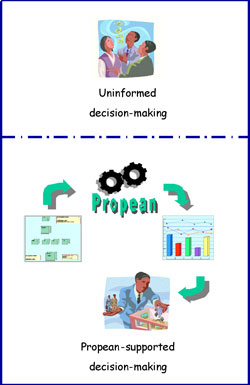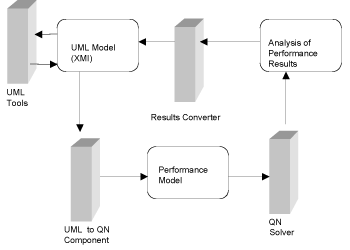|
|||||
Decision Support for Personnel and Resources Management in Multi-Project Environmentsby Antonia Bertolino, Eda Marchetti and Raffaela Mirandola Decision making in project management requires accurate and automated support to monitor and control the development process. Managers must make reliable schedule predictions and optimize personnel utilization. They thus must be able to dynamically evaluate whether the resources assigned to a job are sufficient and whether the organization structure is adequate to meet the scheduled deadlines. To support managers in these tasks, scientists at ISTI-CNR are studying the potential of classical performance engineering and propose the Propean (Project Performance Analysis) methodology. Propean (Figure 1) relies on the metaphor that project teams correspond to the processing resources of classical performance models, and project activities are the tasks to be performed within established time intervals. According to this metaphor, well known techniques from performance analysis can be usefully adapted to managers' needs, for eg assessing the time for completion of specified tasks, handling personnel multitasking over concurrent projects, distributing the workloads in development cycles, deciding about product release, and similar issues. However, a key aspect for the effective deployment of Propean is to adopt an interface that appears familiar to managers. Hence, we adopt as the input modelling notation the UML (Unified Modelling Language) Profile for Schedulability, Performance and Time (RT-UML) recently approved as an OMG standard. In this way, managers do not need to become knowledgeable of performance notations, but can develop a model of the flow of activities and of tasks distribution using the widespread UML notations and tools. The translation into a format that can be processed by performance analysis algorithms is then performed automatically. The SPE Approach
The SM captures the essential aspects of software behavior; it can be represented by means of Execution Graphs, in which nodes are software workload components and edges represent transfers of control. Each node is weighted by use of a demand vector that represents the resource usage of the node. The MM models the hardware platform and is based on Queueing Network (QN) models. The Methodology The methodology is currently being implemented. Figure 2 illustrates the tool architecture including: a UML case tool (specifically ARGO) which processes the input diagrams and generates an XML file; a component which takes as input the XML file and produces the corresponding QN; a QN analytical solver or simulator, which derives the performance analysis results; and finally, a results converter which analyses the performance results and converts them back into UML.
Here below, we outline the basic steps of the Propean methodology: 1. Analysis: definition of project activities (manager) Applications Propean is the result of a collaboration between ISTI-CNR in Pisa, the University of Rome Tor Vergata and Ericsson Lab Italy (ERI) in Rome. It has been applied with encouraging results to some industrial case studies. Here we mention two of them: one is the widespread Rational Unified Process (RUP) customised for a specific ERI project. Considering RUP itself as a product, Propean provided answers to the following questions: How long will RUP take to process a certain project? How will RUP utilize the available resources? How is the RUP schedule affected by the concurrent processing of several projects? The application of Propean to RUP was divided into two steps: the first, called RUP modelling, consisted of the description of the functionality and architecture of the RUP product by means of UML diagrams annotated according to the RT-UML profile. The second step, called RUP customisation, represented the core of Propean application and included the refinement of the UML diagrams according to personnel availability and process requirements. In a second case study, Propean was used to support the decision to release a software product, after testing is completed with no trouble report left open. Propean can assist managers in the early prediction of the expected time until release, considering the actual resource availability (with personnel multitasking). Alternatively, if the release time is fixed with the customer, Propean can help decide the most adequate personnel configuration to fulfil the time constraints. Propean can provide useful support to decision makers in project management. The tool can provide valuable input for analysis, but human expertise remains essential to model the processes, to tune them with the correct values and to interpret the results obtained. Links: Please contact: |
|||||




